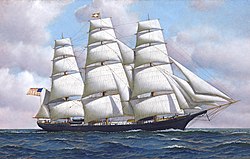Flying Cloud (ship, 1851)
|
The Flying Cloud under full sail (painting by Antonio Jacobsen, 1913)
|
||||||||||||||||
|
||||||||||||||||
|
||||||||||||||||
|
||||||||||||||||
The Flying Cloud was a clipper launched in 1851 and considered to be one of the fastest ships of its time. With a journey time of 89 days and 8 hours, the clipper held the record for the fastest crossing from New York to San Francisco for more than 130 years between 1854 and 1989 . The ship sailed under the US flag until 1862 , after which it was owned by an owner in Liverpool . The Flying Cloud was lost in a shipwreck in 1874 and burned down the following year.
history
Construction and description
The Flying Cloud was in the shipyard of Donald McKay in East Boston built in 1851 and ran from the stack. The client was originally Enoch Train from Boston , who sold the ship to New York's Grinnell, Minturn & Company while it was still under construction. This was a huge win for Train as it only paid $ 50,000 for the clipper, which went to the new owners for $ 90,000.
The Flying Cloud was almost 70 meters long (some sources also mention 71 meters) with a total tonnage of 1,782 GRT, which made it one of the largest clippers of its time. She had a total of three masts and was rigged as a full ship . Some details such as the sail area and the number of sails of the Flying Cloud are as unknown as its exact speed. However, she was considered one of the fastest ships in the world and was touted as America's fastest clipper after commissioning.
The clipper's cargo consisted mostly of tea, wool, cotton and nitrates.
period of service
The Flying Cloud went into service just six weeks after it was launched from New York via Cape Horn to San Francisco, which took the clipper 89 days and 21 hours. He set the record on this route in 1854 with a time of 89 days and 8 hours. In the early days of the California Gold Rush , ships took about 200 days to complete this 16,000-mile passage. The Flying Cloud record lasted 135 years before it was broken in 1989 by the Thursday’s Child slup designed for high speeds .
After setting the speed record and reporting in all the major newspapers, the owner of the clipper Andrew Jackson claimed that his ship had in fact made the fastest crossing. In fact, it only took the Andrew Jackson 89 days and 4 hours to reach the waters around San Francisco. However, between the Farallon Islands and the Golden Gate Strait , the clipper had to anchor for several hours to wait for a pilot. Because of this, the ship reached the port of San Francisco later than the Flying Cloud , which continued to be the official record holder.
In April 1853, the Flying Cloud competed with the Hornet clipper on the route from New York to San Francisco. After a crossing duration of 106 days, both ships arrived almost simultaneously in the port of San Francisco. The Hornet had a lead of only 45 minutes over the Flying Cloud .
In 1862, the Flying Cloud became the property of the Liverpool-based Black Ball Line , who used the clipper to transport wood and occasionally as an immigrant ship to Australia and New Zealand . In later years of service, the ship also called at Saint John in Canada to transport wood .
Shipwreck
On June 19, 1874, the Flying Cloud ran aground at Beacon Island near Saint John. She could be towed free, but her torso was broken and could no longer be repaired. After a year of lay down, all metal fittings were removed from the clipper and the wooden hull burned down.
Female officer
Until 1857, the Flying Cloud had a female officer in Eleanor Creesy (1814–1900), which was extremely unusual at the time and drew a great deal of media coverage. Creesy was the wife of the then captain Josiah Perkins Creesy († 1871), who took over the ship's command together with his wife. The speed record in 1854 was also under their joint command. In 1857, the couple left the Flying Cloud after a financial slump and from then on went to sea, presumably on another ship called the Archer , before retiring in the 1860s.
literature
- David W. Shaw: Flying Cloud: The True Story of America's Most Famous Clipper Ship and the Woman Who Guided Her . HarperCollins , New York 2009, ISBN 978-0688167936
Web links
- Literature from and about Flying Cloud in the bibliographic database WorldCat
- Entry to the Flying Cloud on maritimeheritage.org (English)
- Report on Flying Cloud in The New York Times, July 26, 1987
Individual evidence
- ↑ a b Tony Gibbons: The world of ships . Bassermann Verlag , Munich 2007, ISBN 978-3-8094-2186-3 , p. 112.
- ^ Dan Byrne: Sloop Thursday's Child Sails Into Record Books. In: The Los Angeles Times . February 13, 1989, accessed September 7, 2019 .
- ^ Glenn A. Knoblock: The American Clipper Ship, 1845-1920: A Comprehensive History, with a Listing of Builders and Their Ships . McFarland, Jefferson 2014, ISBN 978-1476602844 , p. 203.
- ^ Octavius Thorndike Howe, Frederick C. Matthews: American Clipper Ships, 1833-1858, Volume 1 . Courier Corporation, North Chelmsford 1986, ISBN 978-0486251158 , p. 269.
- ^ Glenn A. Knoblock: The American Clipper Ship, 1845-1920: A Comprehensive History, with a Listing of Builders and Their Ships . McFarland, Jefferson 2014, ISBN 978-1476602844 , p. 122.


